On Sicily’s western edge, where the Mediterranean brushes the shore, I stumbled upon the stunning salt pans of Trapani. These geometric pools stretch along the coastline, a patchwork of blues and whites shimmering under the Sicilian sun.
The Trapani salt flats aren’t just beautiful—they’re living monuments to an ancient tradition that’s shaped the island’s culinary history for centuries.
As I wandered among the salt pans, the traditional windmills really caught my eye. Locals once used these wooden structures to pump water between basins and grind the harvested salt.
These windmills now stand as silent sentinels, watching over the ongoing harvest. The whole place feels like a time machine, with methods that haven’t changed much since Phoenician times.
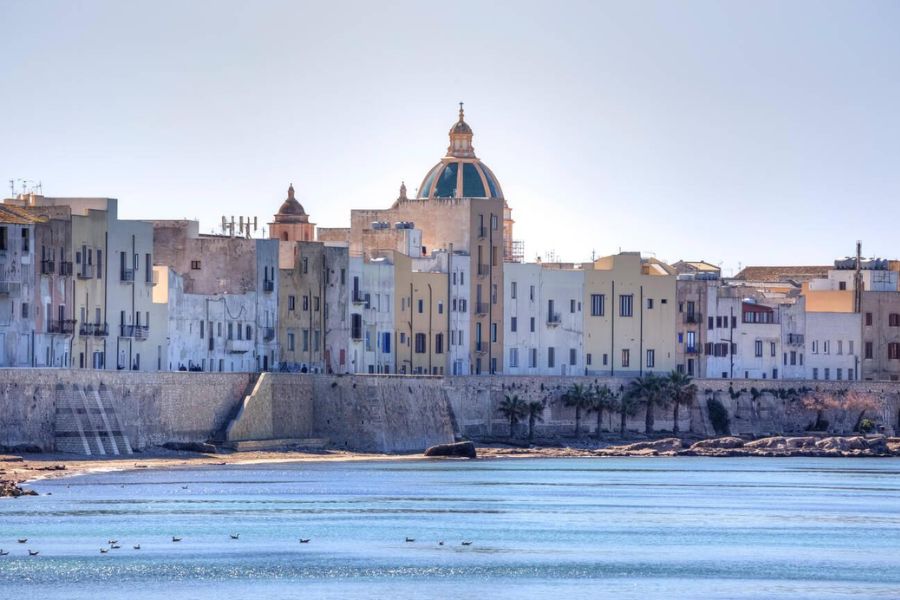
I visited Trapani’s salt pans in summer, right in the middle of the harvest. Local workers raked bright white mounds under the blazing sun, showing me how Mediterranean seawater becomes some of Italy’s most prized sea salt.
This salt isn’t just any seasoning—it’s the backbone of Sicily’s famous cuisine, packed with minerals that give it a flavor chefs all over the world crave.
Discovering Trapani’s Salt Pans
Trapani’s salt pans stretch out along Sicily’s western coast, creating a landscape I’d call unforgettable. These shallow pools reflect the sky, turning seawater into prized Sicilian salt through natural evaporation.

History and Heritage of Salt Production
People have produced salt in Trapani for thousands of years, and the Phoenicians likely started it all. Walking through the area, I can’t help but notice how the process barely changed over the centuries.
The Trapani and Paceco Nature Reserve, protected by the WWF since 1996, keeps this tradition alive. It covers about a thousand hectares of working salt pans where history feels tangible every day.
During my visits, I’ve seen how salt production knits itself into local identity. Families pass down harvesting techniques, building a living heritage that shapes western Sicily’s cultural landscape.
How Sea Water Evaporates to Form Salt
The process? It’s simple, really. Seawater flows into shallow, rectangular pools through channels and gates.
Once inside, the sun and dry winds do their job. Water slowly evaporates, concentrating the salt.
Workers move this brine into smaller and smaller basins, each step boosting the salt concentration. I’ve watched the water change from clear to milky as crystals begin to appear.
In the end, a thin crust of salt forms on top. Salt crystals sparkle in the sunlight—it’s almost magical.
Harvesters use long-handled wooden rakes to collect the crystals. These tools haven’t changed in centuries.
A Day Among the Salt Mounds and Windmills
Late afternoon is my favorite time to visit. The setting sun turns everything gold, and the iconic windmills stand tall over the landscape.
These windmills aren’t just decorative, even though they look fantastic in photos. Some still work, showing off the old engineering that powered salt production before electricity.
As I wander the narrow paths between salt pans, I spot flamingos wading in the shallow water. The salt pans create a unique ecosystem where these pink birds and others thrive.
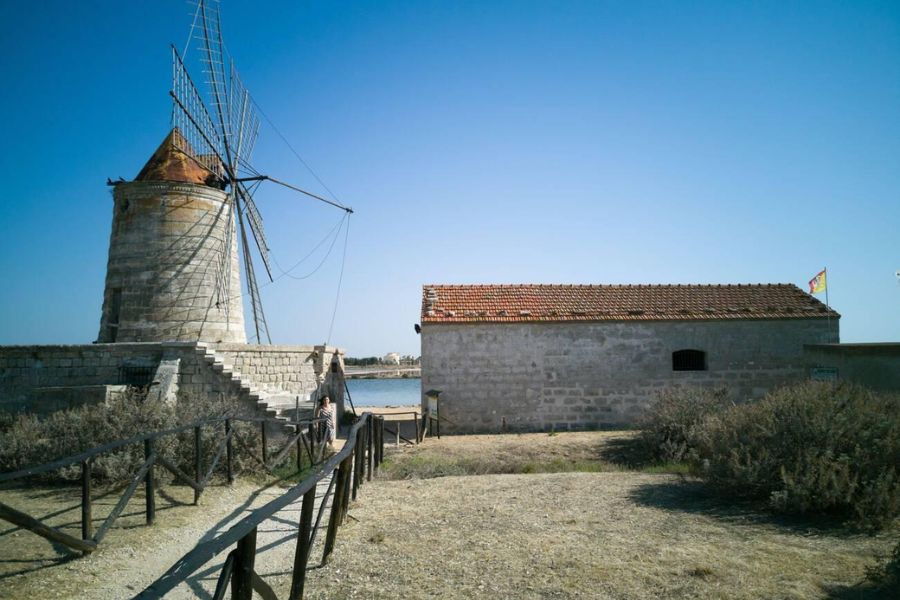
For a real taste of the tradition, I suggest joining a guided tour. Local salt workers share their methods and let you sample different salt varieties.
The fleur de sel from Trapani? It’s got a complexity you just can’t find in store-bought salt.
Iconic Windmills: Guardians of the Salt Flats
Trapani’s windmills stand as historic sentinels along Sicily’s western coast. For centuries, these structures played a key role in salt production, becoming both essential tools and beloved symbols of the region.
Restored Windmills and Their Functions
Walking along the salt flats, I can’t help but admire the windmills scattered across the landscape. Some date back to Phoenician times and served two main purposes in salt-making.
They pumped seawater between basins of different depths, managing the water flow through the pans. They also ground the harvested salt, powered by the Mediterranean winds.
Today, I’ve seen that while many windmills don’t work anymore, several have been carefully restored. The Ettore and Infersa Salt Pans show off some of the best-maintained examples.
Restorers have stayed true to the original designs, with those distinctive red-topped wooden blades standing out against the blue Sicilian sky.
Photographing Trapani’s Most Famous Landmarks
These windmills are a dream for photographers. I find golden hour the best time to capture them, when the sun’s low and the salt pans glow with warm light.
For unique shots, I’d try:
- Dawn photos: When mist hovers over the pans
- Sunset silhouettes: To catch the windmills’ distinctive outlines
- Reflections: Using the still water as a mirror for the windmills
The windmills and salt mounds together create a scene you only find in Trapani. Sure, stock photos exist, but snapping your own is way more satisfying.
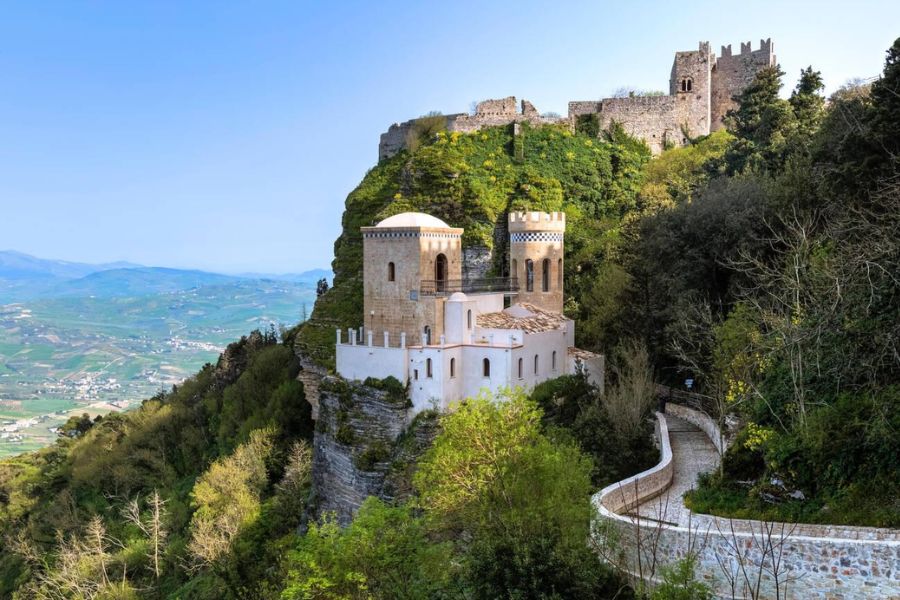
Some windmills are easier to reach than others. Those near the Salt Museum offer good access and plenty of info about their history.
Wildlife and Nature Reserves Along Sicily’s Western Edge
Sicily’s western coastline holds some remarkable ecosystems. Here, salt and sea combine to create perfect conditions for wildlife.
The salt pans don’t just produce famous Trapani salt—they also support a thriving natural habitat.
Riserva Naturale Orientata Saline di Trapani e Paceco
As I walk the ancient salt pans, I notice how this working landscape doubles as a protected nature reserve. The reserve, spanning Trapani and Paceco, preserves both the salt industry and the unique ecosystem.
What makes this place special is the balance between human work and nature. Salt workers still use traditional methods, sharing the space with incredible wildlife.
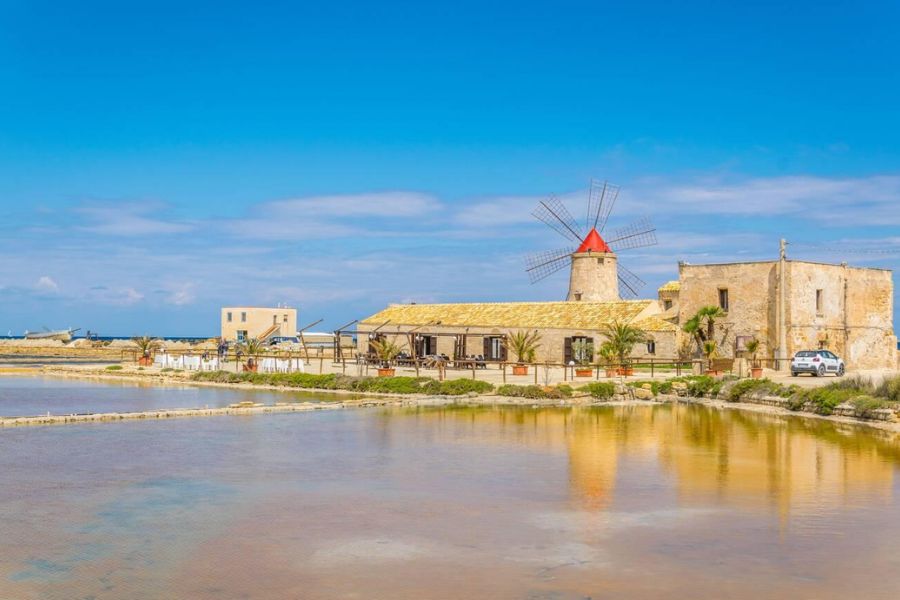
Ancient windmills dot the reserve, their wooden blades turning slowly in the breeze. These structures once pumped seawater between basins and now stand as reminders of the area’s rich history.
Birdwatching: Pink Flamingos and More
The shallow, brackish waters of the salt pans attract loads of bird species. I’ve spent hours watching pink flamingos wade through the waters, their bright feathers popping against the white salt.
Flamingos aren’t here year-round, but when they arrive in groups, it’s quite a sight. Their long legs and curved bills make them perfect for feeding in these shallow waters.
I’ve also spotted great white egrets, herons, and spoonbills while visiting. The reserve draws over 200 bird species throughout the year, including ospreys and marsh harriers soaring above.
Wooden walkways and observation points make wildlife viewing easy without disturbing the birds. I’d bring binoculars for the best view.
Must-Visit Destinations Near Trapani
Trapani’s salt pans are amazing, but the surrounding area has even more to offer. I’ve found these nearby spots perfect for day trips that show off western Sicily‘s variety.
Marsala and Its Sweet Dessert Wine
Marsala sits just 30 minutes south of Trapani. It’s a charming coastal city with a rich history and, of course, world-famous wine.
I spent an afternoon wandering its Baroque center, where amber buildings line wide streets and elegant piazzas.
The real treat was visiting a local winery for a taste of Marsala wine. This sweet, fortified wine put the town on the map centuries ago.
Many wineries offer tours where you can learn about the aging process in oak barrels.

Marsala’s coast also features salt pans, similar to Trapani’s but with their own vibe. I watched an unforgettable sunset here, with salt farmers collecting crystals as the sky turned pink and orange.
The Ancient Island of Mothia
One of my favorite finds was Mothia (or Mozia), a tiny island in the Stagnone Lagoon near Marsala. You can reach it by a short boat ride across shallow water.
The Phoenicians founded Mothia around 800 BC, making it a major trading post. Today, you’ll find remarkably preserved ruins that tell fascinating stories about ancient Mediterranean life.
The on-site Whitaker Museum displays the stunning “Youth of Mozia” statue, a Greek marble masterpiece.
Walking the island’s paths, I felt like I’d stepped back in time. Ancient stone walls, pottery shards, and remnants of a defensive moat surround you. The peaceful setting, with Trapani visible in the distance, creates a magical atmosphere.
Erice: A Hilltop Town with a Castle
Erice rises dramatically 750 meters above Trapani. I took the cable car up (though you can drive too) and found myself in what honestly feels like a fairytale.
Cobblestone streets wind between ancient stone buildings, opening to breathtaking viewpoints over the coast. On clear days, you can see all the way to Africa!
The Norman Castle, built on ancient Elymian foundations, offers the best panoramic views.
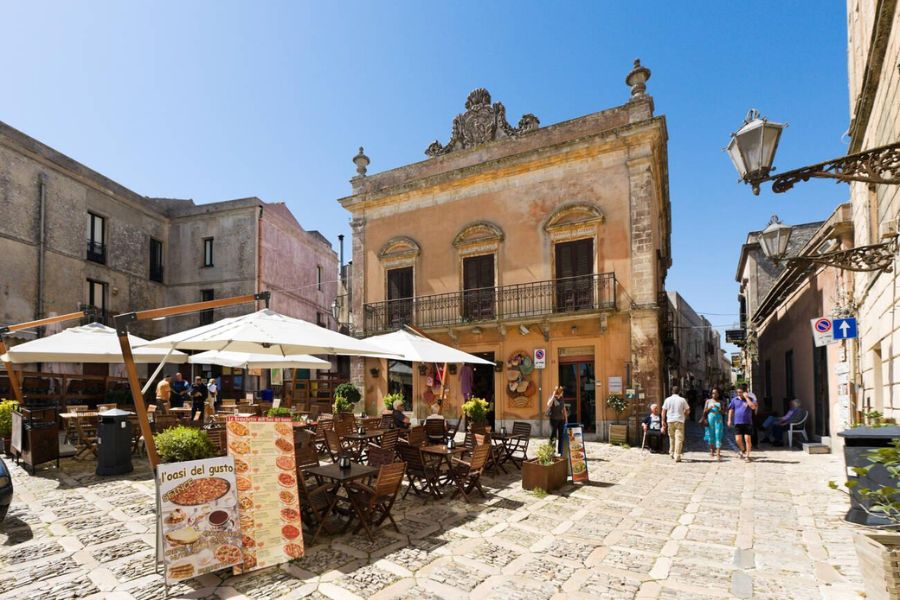
Erice is famous for its pastry shops—nuns here once created sweet almond treats. I couldn’t resist Maria Grammatico’s pasticceria for her legendary cookies.
The cool mountain air and frequent mist give the town an enchanting, almost mysterious vibe that fits its history.
Exploring Sicily’s West: Culture, Sea, and Unforgettable Views
Western Sicily pulls you in with its blend of natural beauty, deep history, and lively culture. There’s so much more than just salt pans—stunning coastlines and connections to some of Sicily’s most important spots await.
Beaches and the Mediterranean Sea
I’ve found the beaches along Sicily’s western coast to be some of the island’s best. San Vito Lo Capo, with its crescent of white sand and turquoise water, feels like a slice of the Caribbean right here.
Near Trapani, the coast mixes sandy stretches with rocky coves. In summer, I love swimming at Marausa beach, just a short drive from town. The shallow water is great for families.
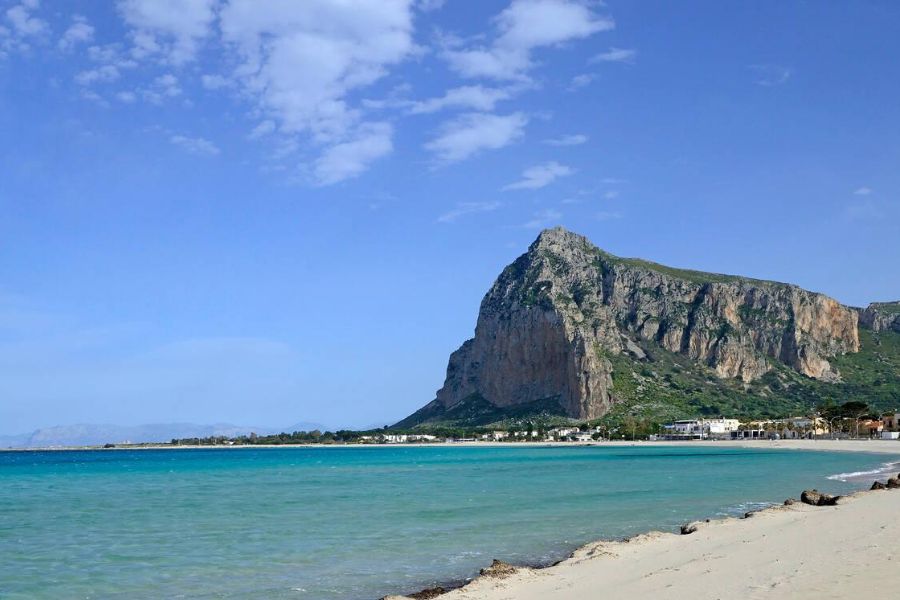
What stands out is how the Mediterranean and Tyrrhenian Seas meet, creating unique water conditions. The blue color here is something photographers chase, but photos never quite capture it.
Day Trips to Egadi Islands and Scopello
From Trapani’s port, I often hop on a ferry to the Egadi Islands. Favignana, the biggest, is known as “La Farfalla” (The Butterfly) for its shape.
Its crystal waters and hidden coves make it perfect for swimming and snorkeling.
Levanzo and Marettimo offer quieter escapes with fewer tourists. I’d recommend hiking Marettimo’s trails for sweeping Mediterranean views.
Scopello, just a short drive from Trapani, boasts one of Sicily’s most photographed scenes—the old tuna fishery (tonnara) with its sea stacks. The nearby Zingaro Nature Reserve has gorgeous hiking trails and secluded beaches you can only reach on foot.
Connections to Palermo, Segesta, and Selinunte
I usually stick with Trapani as my base when I’m exploring western Sicily’s historical gems.
Palermo, the island’s lively capital, sits just about an hour’s drive away. You really shouldn’t skip the colorful markets or the impressive Norman architecture—they’re both unforgettable in their own ways.
Segesta shows off one of the best-preserved Greek temples anywhere. The 5th-century BC monument stands alone on a hillside, casting a dramatic silhouette against Sicily’s rolling landscape.
You’ll find Selinunte further south, with its massive archaeological park spread across 270 hectares. Every time I wander among the fallen columns of this once-mighty Greek city, I can’t help but feel how close the past still is.
The drive between these sites winds through Sicily’s interior. Vineyards, olive groves, and tiny villages pass by, and honestly, the whole place feels like it hasn’t changed in ages.

